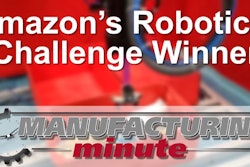While the manufacturing industry has experienced tumultuous changes over the past decade, the last few years have provided some reason for optimism. After reaching a low point of 11.5 million jobs in 2010, a resurgence in American manufacturing — spurred largely by technology — has seen employment jump to more than 12.3 million by the end of 2016. With the introduction of automation, robotics, and advanced manufacturing, workers are now producing 47 percent more than they were 20 years ago.
Maintaining competitiveness, however, remains a huge issue for most manufacturing firms. To keep their edge, manufacturers are being encouraged to invest in technology, deploy data analytics, and embrace emerging tools such as 3D printing and smart appliances.
For manufacturers to maximize the return on these substantial technology investments, change management is key. If a manufacturer can create a change management structure that will successfully support the implementation of a new technology, it significantly improves its chances for optimizing the return on its technology investment.
It is important that all employees who are impacted by a new technology implementation understand what will change, how it will change, when it will change, and why it will change. With the right knowledge in hand, teams will be better positioned to use the new technology effectively, and gain the intended benefits of the technology investment for both themselves and their company.
Knowing which teams and systems will be impacted by a new technology, and then preparing them for impending changes, can be a challenge. Examining current business processes and understanding not only what they are designed to accomplish, but why they were established in the first place, is a good place to start.
Here are two examples that demonstrate how business process management can help or hinder new technology implementations. In the first, the manufacturer attempted to consolidate two business units. The company was deploying an enterprise resource planning (ERP) system to integrate both units’ core business processes, yet neither unit had completely documented its current business processes prior to implementation.
Issues arose almost immediately because neither the ERP vendor nor the systems integrator understood the manufacturer’s business processes. Implementation immediately slowed to a crawl, causing problems with segregation of duties (SoD) in the processes. All of this impacted the effectiveness of the new system, while simultaneously undermining staff confidence in using it.
In contrast, the second manufacturer began its technology implementation by capturing all its current business processes, including variations and future state processes. The manufacturer also created a series of detailed use cases in order to clarify system requirements and speed the design phase.
These initial steps put the manufacturer in a significantly better position to consider possible technology options, structure testing in order to get the desired coverage, and validate its thinking by getting input from all of its stakeholders. This approach helped the company to deal directly with any issues or process variations presented by the two business units, while simultaneously creating staff buy-in.
With that in mind, I would suggest there are four key factors which manufacturers should consider in order to maximize the return on their technology investments.
First, manufacturers should capture and understand all of the current processes they employ, including any process variations. As the example above illustrates, companies don’t always appreciate the complexity of their own processes — as well as any nuances or variations that exist within those processes — until they see them mapped.
It is also essential for the manufacturer to take ownership of its own processes. An outsider, no matter how savvy, will never know the business as well as the in-house team. So while some external assistance might be helpful, process ownership should never be delegated completely to an outside vendor.
Next, it’s important for the manufacturer to get everyone impacted by technology changes on the same page. Doing so will help to overcome any resistance to change, preempt the doubts that sometimes follow, and create buy-in. All areas of the operation which will be impacted by a technology implementation should be involved in both current and future state workshops. Doing so will help to inform the processes, while giving employees a better understanding of not only what changes are being made, but why they are being made.
Finally, upfront planning and analysis will ease decision-making and pay off in the long run. Taking the time to get a clear understanding of the manufacturer’s processes and their desired outcomes will make it easier to make the right decisions about what technology solutions are needed, as well as their design, testing, and training.
Clearly, technology investments are a necessity for today’s manufacturers. To drive successful change and maximize the return on these technology investments, start with your business processes. Doing so will positively impact both your employees and your bottom line.
Ivan Seselj is CEO of Promapp Solutions.






















